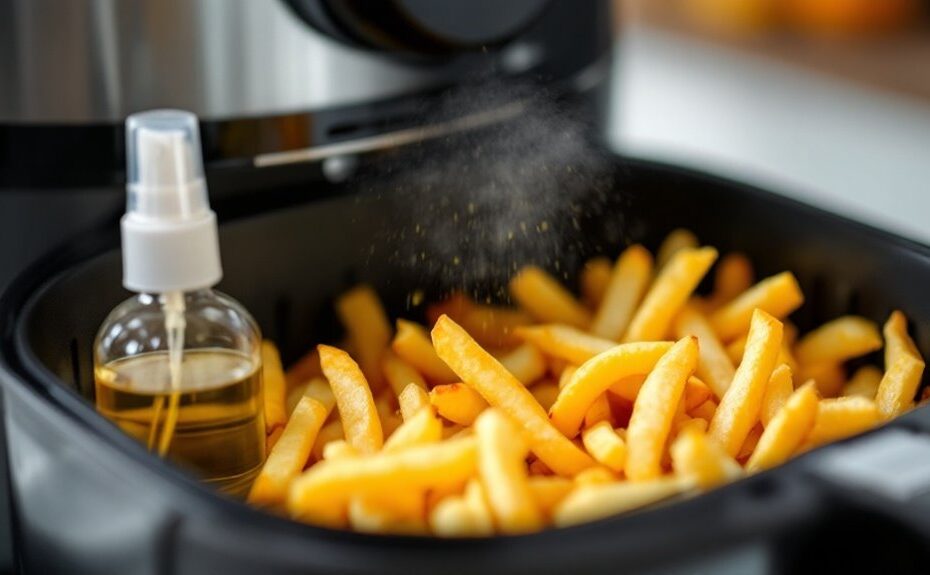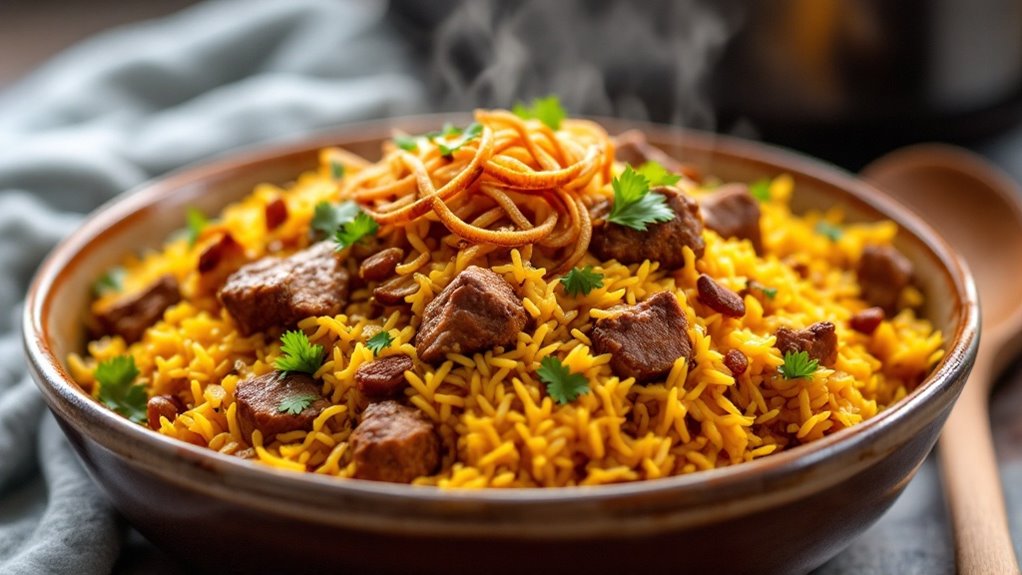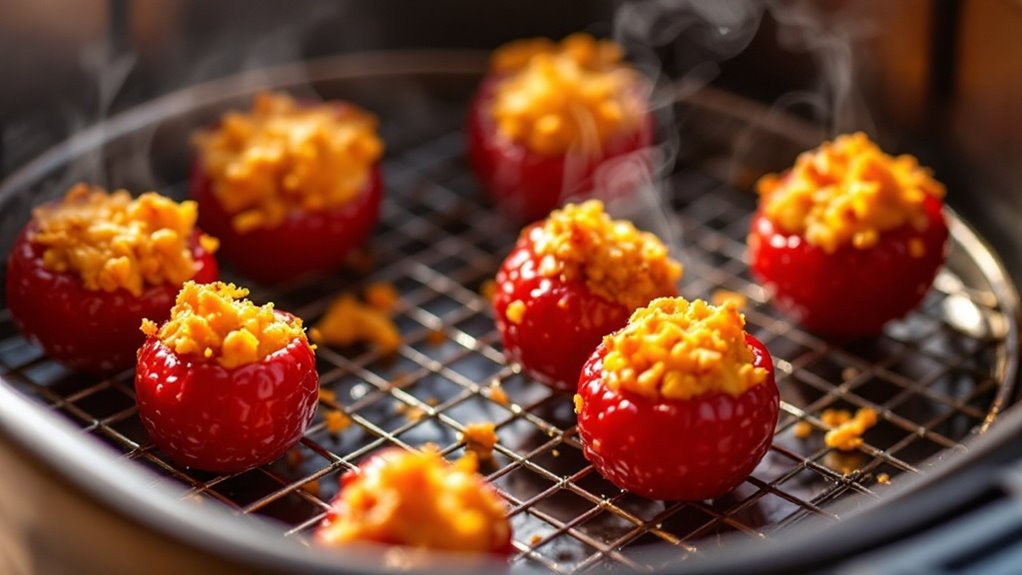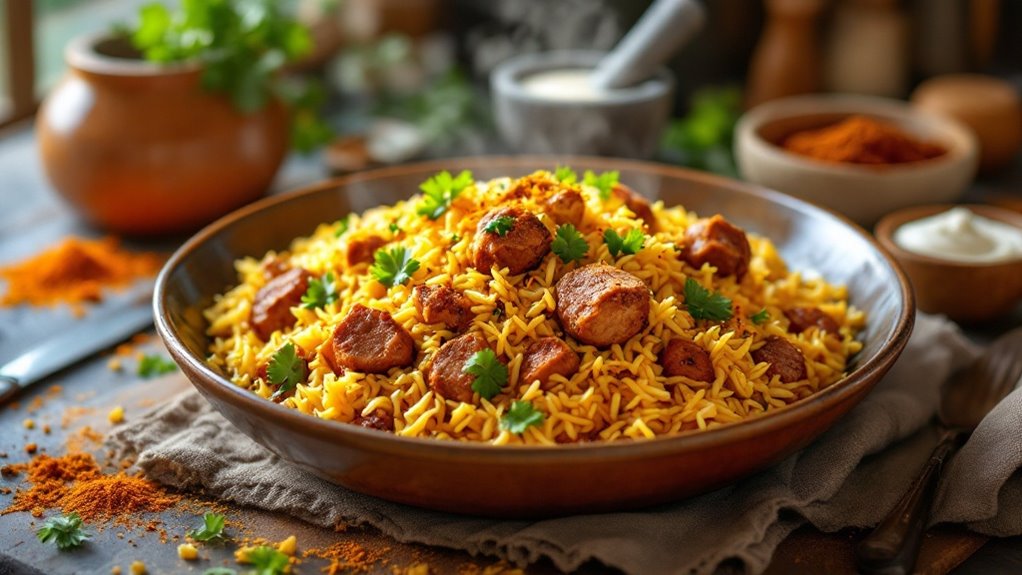Cutting back on oil in your air fryer doesn't mean sacrificing flavor or texture—it's about working smarter, not harder. You can start by choosing the right tools, like a high-heat cooking spray or non-stick liners, to keep food from sticking without drenching it. Preheating your air fryer and avoiding overcrowding the basket also go a long way in ensuring even cooking with minimal oil. But what if you could enhance your meals with dry seasonings or citrus instead? The possibilities are more versatile than you might think, and the results might just surprise you.
Key Takeaways
- Use high-heat cooking sprays like avocado or canola oil sparingly for a light, even coating without pooling.
- Opt for non-stick alternatives like parchment paper or silicone liners to minimize oil usage and simplify cleanup.
- Preheat the air fryer and avoid overcrowding the basket to ensure even cooking and crispiness with less oil.
- Enhance flavor with oil-free coatings like breadcrumbs, spices, or citrus juice instead of relying on oil.
- Clean the air fryer regularly to prevent grease buildup and maintain efficient, low-oil cooking performance.
Choose the Right Cooking Spray
When using an air fryer, selecting the right cooking spray is essential to achieving a crispy texture without excess oil. Opt for spray types specifically designed for high-heat cooking, such as avocado or canola oil sprays, as they have higher smoke points. Avoid aerosol sprays with propellants, as they can damage the air fryer basket's nonstick coating. Instead, use pump sprays or misters for better control over oil distribution. Your spray technique matters—hold the bottle 6-8 inches away and apply a light, even layer to prevent pooling. Over-spraying can lead to soggy results, so aim for minimal coverage. Always check the ingredient list to confirm the spray contains only oil, avoiding additives that may affect flavor or performance. Proper spray selection and application maximize crispiness while reducing oil usage.
Use Parchment Paper or Liners
To minimize oil usage and simplify cleanup, parchment paper or silicone liners can be a game-changer for air frying. The parchment benefits include preventing food from sticking to the basket, reducing the need for excess oil. It also guarantees even cooking by allowing proper airflow. Silicone liners offer similar liner advantages, such as reusability and durability, making them a cost-effective option. Both options create a non-stick surface, so you won't need to coat your food or basket with oil. Just make sure the liner or parchment fits your air fryer basket without blocking the heating element. These tools not only cut down on oil but also make post-cooking cleanup effortless. By incorporating them, you'll achieve healthier, crispier results with minimal effort.
Opt for Low-Oil Recipes
Since air fryers are designed to cook with little to no oil, choosing low-oil recipes maximizes their health benefits while still delivering crispy, flavorful results. Focus on recipes that use low oil marinades, such as lemon juice, vinegar, or yogurt-based mixtures, to infuse flavor without excess fat. For coatings, opt for oil free options like breadcrumbs, panko, or crushed nuts, which crisp up beautifully in the air fryer. You can also use spices, herbs, or nutritional yeast to add depth without relying on oil. When preparing vegetables or proteins, lightly mist or brush them with minimal oil instead of submerging them. By prioritizing low-oil recipes, you'll reduce calorie intake while maintaining the satisfying texture and taste that air frying is known for.
Preheat the Air Fryer Properly
Preheat your air fryer to the ideal temperature settings recommended for your recipe to guarantee even cooking and reduce the need for excess oil. Avoid overcrowding the basket, as this can block airflow and lead to uneven results, forcing you to add more oil for crispiness. Proper preheating and spacing allow the hot air to circulate efficiently, delivering better texture with minimal oil.
Optimal Temperature Settings
For best results when using an air fryer, setting the right temperature and preheating it properly guarantees even cooking and crispiness. Start by preheating your air fryer to the recommended temperature for your food, typically between 350°F and 400°F. This secures the cooking process begins immediately, reducing oil usage while maintaining texture. Use temperature control tips like adjusting settings based on food type—lower temps for delicate items, higher for crispy results. Avoid frequent temperature changes to save energy and improve energy efficiency hacks. Always check your air fryer's manual for specific guidelines, as models vary. Proper preheating and precise temperature settings not only enhance food quality but also minimize oil reliance, making your meals healthier and more efficient.
Avoid Overcrowding Basket
To guarantee even cooking and ideal crispiness, avoid overcrowding the air fryer basket, as it restricts airflow and leads to uneven results. Proper basket spacing secures hot air circulates freely, crisping food evenly without excess oil. Arrange food in a single layer, leaving gaps between items for peak air flow. If cooking larger batches, work in smaller portions to maintain consistent results. Overcrowding traps steam, creating soggy textures and requiring longer cook times. Pay attention to food arrangement, placing larger or denser items toward the edges and smaller pieces in the center. This method maximizes efficiency and reduces the need for added oil. By prioritizing proper spacing, you'll achieve crispy, evenly cooked dishes while minimizing oil usage.
Toss Food in Minimal Oil
When using an air fryer, tossing your food in minimal oil guarantees a crispy texture without excess grease. Start by lightly coating your ingredients with an oil-free coating, such as breadcrumbs or cornstarch, to enhance crispiness. Use a spray bottle application to evenly distribute a thin layer of oil, ensuring every piece gets just enough to crisp up without soaking. This method prevents over-saturation and reduces overall oil usage. Focus on tossing the food gently to distribute the oil evenly, avoiding clumps or dry spots. By using minimal oil, you'll achieve a satisfying crunch while keeping your meal healthier. Remember, less oil doesn't mean less flavor—proper seasoning and technique will still deliver delicious results.
Use Oil Alternatives for Flavor
You can enhance flavor without relying on oil by incorporating citrus zest, which adds brightness and aroma to your dishes. Fresh or dried herbs like rosemary, thyme, or oregano infuse depth and complexity, while spice blends such as paprika, cumin, or chili powder deliver bold, savory notes. These alternatives not only reduce oil but also elevate the taste profile of your air-fried meals.
Use Citrus Zest
Citrus zest can add a burst of flavor to your air-fried dishes without relying on oil. Grate the outer peel of lemons, limes, or oranges to create zest rubs that infuse your food with bright, tangy notes. Combine the zest with spices or herbs and rub it onto proteins or vegetables before air frying. For a deeper flavor, incorporate citrus marinades by mixing zest with vinegar, garlic, or a splash of juice. The natural oils in the zest enhance moisture and taste, eliminating the need for added fats. Avoid the bitter white pith when zesting, as it can overpower the dish. Citrus zest works particularly well with chicken, fish, or roasted vegetables, delivering a fresh, oil-free alternative that elevates your air-fried meals.
Incorporate Herbs
To infuse your air-fried dishes with robust flavor without relying on oil, fresh or dried herbs can be a game-changer. Sprinkle rosemary, thyme, or oregano directly onto vegetables, proteins, or starches before air frying to enhance their natural taste. For a deeper flavor profile, create herb-infused oils by steeping herbs like basil or garlic in a small amount of oil, then lightly brushing it onto your ingredients. Alternatively, skip the oil entirely and use fresh herb garnishes like chopped parsley, cilantro, or dill after cooking to add brightness and complexity. Dried herbs work well too, especially when rehydrated with a splash of water or broth. These techniques deliver rich, aromatic results while keeping oil usage to a minimum.
Add Spice Blends
While oil can enhance the flavor of spice blends, it's not essential for creating bold, aromatic dishes in an air fryer. You can achieve rich, complex flavors by using dry spice combinations or seasoning mixes directly on your food. Experiment with blends like smoked paprika, cumin, and garlic powder for a smoky kick, or try turmeric, coriander, and chili powder for a vibrant, earthy profile. These dry mixes adhere well to ingredients without oil, especially if you lightly moisten the surface with water or citrus juice. For a zesty twist, sprinkle lemon pepper or za'atar over vegetables or proteins. By relying on spice blends, you'll infuse your dishes with depth and reduce oil usage without sacrificing taste.
Avoid Overcrowding the Basket
When using an air fryer, it's vital to avoid overcrowding the basket, as this can hinder proper air circulation and lead to uneven cooking. Proper basket spacing guarantees hot air reaches all surfaces of your food, reducing the need for excess oil to achieve crispiness. Stick to portion control by cooking in smaller batches if necessary. Overloading the basket traps moisture, resulting in steamed rather than crispy food, which often prompts you to add more oil. Instead, arrange items in a single layer with space between them. This allows the air fryer to work efficiently, delivering evenly cooked, golden results without relying on additional oil. Prioritize spacing and portion control to maximize your air fryer's performance and minimize oil usage.
Flip Food for Even Cooking
Flipping food during the cooking process guarantees even browning and crispiness on all sides. To achieve consistent results, use proper food rotation techniques. For smaller items like fries or wings, shake the basket halfway through cooking. For larger items such as chicken breasts or fish fillets, flip them manually using tongs. Follow flipping frequency tips based on the food type: flip every 5-7 minutes for thicker cuts and every 3-4 minutes for thinner items. This secures heat distributes evenly, reducing the need for excess oil to prevent sticking or uneven cooking. Avoid over-flipping, as it can disrupt the air fryer's circulation and extend cooking time. By mastering these techniques, you'll maximize crispiness and minimize oil usage effortlessly.
Experiment With Dry Seasonings
To enhance flavor without adding extra oil, experiment with dry seasonings in your air fryer. Dry rubs and seasoning blends are excellent alternatives to oil-based marinades, as they adhere well to food and create a flavorful crust during cooking. Apply a generous layer of your chosen seasoning blend—such as garlic powder, paprika, or cumin—directly to proteins or vegetables before air frying. For a more intense flavor, let the dry rub sit on the food for 10–15 minutes before cooking. Avoid overloading with salt-heavy mixes, as the air fryer's intense heat can concentrate flavors. Opt for herb-based blends or citrus-infused rubs to keep dishes light and vibrant. This method not only reduces oil usage but also elevates the taste and texture of your meals.
Clean the Air Fryer Regularly
Since the air fryer relies on high heat and circulating air to cook food, it's vital to clean it regularly to maintain performance and prevent lingering odors or residue buildup. Establish a consistent cleaning frequency, ideally after every use, to avoid grease accumulation and guarantee efficient operation. Wipe down the exterior with a damp cloth and clean the basket, tray, and pan with warm, soapy water. For stubborn residue, soak parts in soapy water before scrubbing. Avoid abrasive tools that could damage nonstick coatings. Check the heating element for debris and wipe it gently with a soft brush or cloth. These maintenance tips not only extend your air fryer's lifespan but also help reduce oil usage by guaranteeing even heat distribution and preventing cross-contamination from old residues.
Disclosure: As an Amazon Associate, I earn from qualifying purchases.



